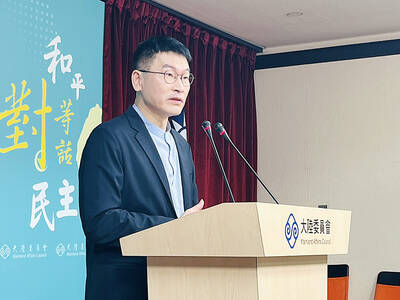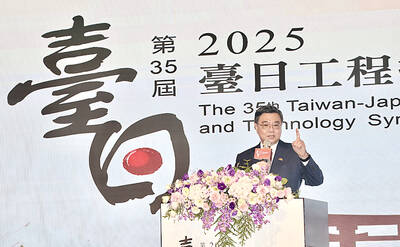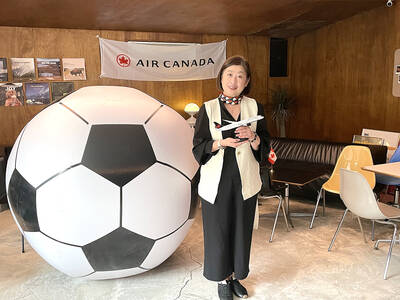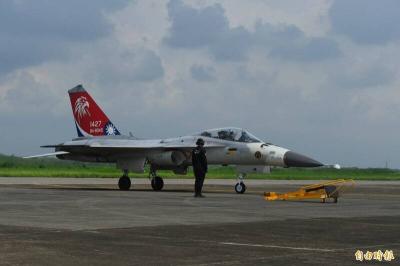The funeral of Lee Hsin-kai (李新凱), an uncle of China’s first lady, Peng Liyuan (彭麗媛), was held yesterday in Chiayi.
Lee, a long-time Chinese Nationalist Party (KMT) member and Chiayi resident, died on Nov. 11 at the age of 86.
As Peng was not able to attend the ceremony, her brother, Peng Lei (彭磊), represented the Lee family.
Peng Lei arrived at the Chiayi Funeral Parlor at 8am and left at about 8:40am after burning incense and paying his respects.
The funeral was a low-key affair and the service was not open to the media. The family had hired security personnel to keep the event private.
KMT Chairwoman Hung Hsiu-chu (洪秀柱), KMT Vice Chairman Huang Min-hui (黃敏惠) and other party officials attended to pay their respects to Lee, as did People First Party Secretary-General Chin Chin-sheng (秦金生) and Deputy Secretary-General Liu Wen-hsiung (劉文雄).
The Democratic Progressive Party was represented by Secretary-General Hung Yao-fu (洪耀福),
President Tsai Ing-wen (蔡英文) and former president Ma Ying-jeou (馬英九) sent flowers.
Lee fled to Taiwan as a student and joined the army after the end of the Chinese Civil War in 1949. He later taught elementary school.
After his retirement more than two decades ago, Lee, his daughter and son-in-law lived in Chiayi.
Lee led an unassuming life and after Xi Jinping (習近平) became Chinese president, he was particularly cautious, with only a few people in the neighborhood aware he that he was related to Xi’s wife.
Peng Liyuan, a singer who served as a civilian member of the Chinese People’s Liberation Army, visited Taiwan in 1997 as part of a cultural exchange group. Since Chiayi was not on the group’s itinerary, she invited Lee and his family to Taipei for a family gathering.
She later invited her uncle to visit her in China.

LOW RISK: Most nations do not extradite people accused of political crimes, and the UN says extradition can only happen if the act is a crime in both countries, an official said China yesterday issued wanted notices for two Taiwanese influencers, accusing them of committing “separatist acts” by criticizing Beijing, amid broadening concerns over China’s state-directed transnational repression. The Quanzhou Public Security Bureau in a notice posted online said police are offering a reward of up to 25,000 yuan (US$3,523) for information that could contribute to the investigation or apprehension of pro-Taiwanese independence YouTuber Wen Tzu-yu (溫子渝),who is known as Pa Chiung (八炯) online, and rapper Chen Po-yuan (陳柏源). Wen and Chen are suspected of spreading content that supported secession from China, slandered Chinese policies that benefit Taiwanese and discrimination against Chinese spouses of

ALIGNED THINKING: Taiwan and Japan have a mutual interest in trade, culture and engineering, and can work together for stability, Cho Jung-tai said Taiwan and Japan are two like-minded countries willing to work together to form a “safety barrier” in the Indo-Pacific region, Premier Cho Jung-tai (卓榮泰) yesterday said at the opening ceremony of the 35th Taiwan-Japan Modern Engineering and Technology Symposium in Taipei. Taiwan and Japan are close geographically and closer emotionally, he added. Citing the overflowing of a barrier lake in the Mataian River (馬太鞍溪) in September, Cho said the submersible water level sensors given by Japan during the disaster helped Taiwan monitor the lake’s water levels more accurately. Japan also provided a lot of vaccines early in the outbreak of the COVID-19 pandemic,

PROMOTION: Travelers who want a free stopover must book their flights with designated travel agents, such as Lion Travel, Holiday Tours, Cola Tour and Life Tours Air Canada yesterday said it is offering Taiwanese travelers who are headed to North America free stopovers if they transit though airports in Japan and South Korea. The promotion was launched in response to a potential rise in demand for flights to North America in June and July next year, when the US, Canada and Mexico are scheduled to jointly host the FIFA World Cup, Air Canada said. Air Canada offers services to 13 of the 16 host cities of the tournament’s soccer games, including Toronto and Vancouver; Mexico City, Guadalajara and Monterrey in Mexico; Atlanta, Georgia; Boston; Dallas; Houston;

The US approved the possible sale to Taiwan of fighter jet spare and repair parts for US$330 million, the Pentagon said late yesterday, marking the first such potential transaction since US President Donald Trump took office in January. "The proposed sale will improve the recipient's capability to meet current and future threats by maintaining the operational readiness of the recipient's fleet of F-16, C-130," and other aircraft, the Pentagon said in a statement. Trump previously said that Chinese President Xi Jinping (習近平) has told him he would not invade Taiwan while the Republican leader is in office. The announcement of the possible arms